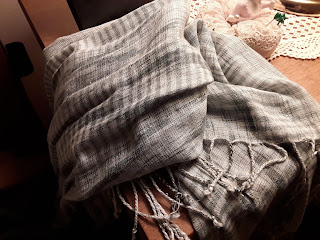Marie Kondo seems to be getting more popular than ever--she now has a show on Netflix (which I can't watch because we just unsubscribed). The word most often applied to her personally is "cute," but she also has her firm side. In one You-tube video, the owner of a messy pantry shows her a package of spoon-shaped cookies, drawing appreciative coos from Kondo but followed quickly by a pointing out of their months-old expiry date. Cute cookies aren't worth much if you don't eat them.
In 2017, I read
The Life-Changing Magic of Tidying Up, and described some of my early experiments on the blog. Someone commented (kindly) that it would be interesting to know how long I'd stick with it.
Well, it's been a year-plus since I made my first t-shirt stand up straight, so I guess that's long enough now to call a habit. The food in our storage room has remained organized (and the wrapping paper I used on the bins has held up pretty well). The bathroom has stayed uncluttered. We had already gone through a lot of decluttering, during our downsize to the apartment. I had also done quite a lot of putting things into containers, and containers within containers, before I read
Tidying Up.
What I think KonMari added to our vision for a newer, cleaner space here was a sense of aesthetic pleasure, an extra bit of harmony. One of the odd bits I picked up from Kondo's books was the idea that containers and boxes with clashing labels and random printing may contribute to a sense of info-overload. They can feel like commercials that never get turned off. Solutions to garish containers include peeling off a label, painting or covering the box (as I did with the very miscellaneous pantry bins), or emptying the contents into a jar or something else neutral. If it's a shoebox or something to be repurposed as a drawer organizer, then the outside printing doesn't matter. But if the storage container is going on a shelf, you might want to pretty it up a bit. That doesn't mean crocheted cozies for the toilet paper, but just keeping in mind how what we look at every day can boost moods (or bring them down). If we have to look at words in our homes, let's make them important and beautiful words.
I appreciate Kondo's encouragement to use whatever you have instead of buying new (often plastic) storage goods. One thing she does like are the sets of large plastic drawers for closets, partly because they keep storage behind closed doors. I don't have any, but I've compromised by treating a couple of under-bed baskets as if they were drawers. (We don't get as many dust-bunnies here as we did at our old house, so under-bed storage is workable.)
Another KonMari idea that I found useful was sorting by categories, especially with seemingly miscellaneous stuff. Not that we hadn't already done a lot of that, but I appreciated her emphasis on its usefulness. It helps us know not only where things are in the apartment, but also when we need to re-stock.
Finally, Kondo's knack for turning even an underwear drawer into a sort of Bento box array should lead not to obsession with one's undies, but to appreciation and gratitude for what we have. This is something we can share with and model for children. Look--we have socks! They're nice colours! They're clean! They're (mostly) hole-free! Let's take care of them! Even small things arranged carefully can make our days brighter, and that echoes Edith Schaeffer's thoughts on tabletop flowers, sandwich plates for hobos, and writing little notes to cheer people up.
I still don't talk to my shoes. But I'm glad for the help KonMari has given us.
"Yet it was chiefly her body that was tired now; her mind, which had been so weary and fretted in London, had been wonderfully rested by this house that was now her home....[Nadine] stretched out a hand and laid it upon the paneled wall beside her; it was warm in the sun, as though it were alive....This house was maison-dieu [a house of God], and the stripping away of all that was unworthy and the building up of new beauty was in the nature of a crusade. And the house had agreed and collaborated." ~~ Elizabeth Goudge, The Herb of Grace (Pilgrim's Inn)























